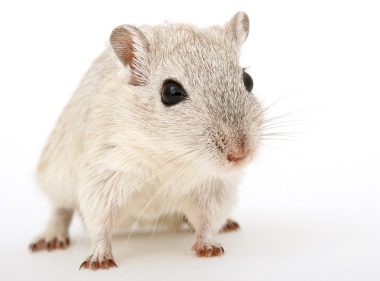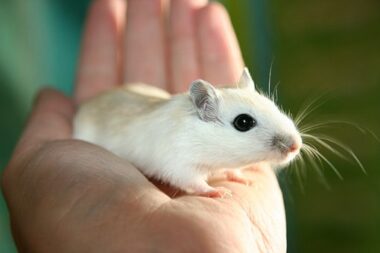
Gerbils are found in arid conditions in Africa, India, and other Asian countries. They need to take sand baths to maintain their body temperature. They have a harderian gland that is present behind their eye, and which secretes the waxy porphyrin that resembles red tears. This waxy porphyrin is mixed with the gerbil’s saliva, which the gerbil then spreads on its coat.
The amount of porphyrin spread on the coat depends on the temperature. The porphyrin is used to retain body heat in winter, while a lower amount of porphyrin helps in better cooling. The use of water to give gerbils a bath may reduce the amount of porphyrin on the skin, affecting the maintenance of body temperature.
Why do you need to bathe gerbils?
Gerbils love to burrow in compost, which could result in its coat looking dirty. A good bath will help its coat look shiny again. Ideally, a gerbil should be given a sand bath at least once every week. The sand helps remove all the dirt from the gerbil’s coat and soak up any excess oil present on the coat.
Sand baths are an evolutionary adaptation of gerbils to remain clean in their natural habitat. They roll in the sand and then shake off the excess sand, resulting in shiny clean coats.
Gerbils should not be bathed with water as it could result in the loss of essential oils from their coat, with the risk of developing skin conditions. A water bath should be given only if there is something potentially harmful stuck to the gerbil’s hair, during times of emergency.
Step 1: Get the right vessel
The vessel that you choose to give your gerbil a bath should be wide enough for the gerbil to be able to roll in it. It should also be deep enough for you to add sand to it.
A cat dish may be suitable, or there are special dishes that you can purchase at a pet store to ‘run’ the sand bath. The dish should fit into the gerbil tank. The depth of the dish should be 3 inches, preferably with a handle so it is easy to place it inside the tank and remove it. The dish, along with the handle should be accommodated into the gerbil tank, so make sure that the handle is collapsible.
Step 2: Get the right sand
The right sand for a gerbil bath is Chinchilla sand, but not Chinchilla dust. Chinchilla dust is known to cause respiratory problems in gerbils, and so should be avoided. The sand used to bathe the gerbil should be free from silica and from dyes. The Chinchilla sand will be found in any of the pet stores.
Step 3: Fill the Chinchilla bath with sand:
The chinchilla sand should be poured onto the bath dish till about a height of half an inch. This should ideally cover half the height of the dish.
Step 4: Place the bath in the gerbil tank:
Find a suitable place in the gerbil tank and then place the bath in it. Ensure that the gerbil is awake and notices the bath being placed.
The bath should be placed in the gerbil tank for only 10 minutes, so your gerbil gets to bathe till then.
The gerbil will learn that once its sand bath is placed, it gets to roll in it for a period of time before you take it away. You need to ensure that its coat is clean before taking the sand bath out. During the first few times, you may have to leave the sand bath in the gerbil tank a little longer.
Some people prefer to keep the sand bath in the gerbil tank permanently. This could result in the gerbil pooping in the sand bath, making the sand bath dirty and defeating its very purpose. To avoid its use as a toilet, take the bath away after allowing the gerbil to roll in it for about ten minutes.
Gerbil sand bath
Your gerbil will bathe on its own, it will run in and out of the bath or it may kick about the sandpit for some time. You will catch it rolling in the sand for a bit. Don’t intervene and enjoy the show. It will be funny and cute at the same time.
There will be times when you may have to reach out and help it adjust especially if it doesn’t take to the sand bath. Then you may have to pick up the gerbil and place it on the sand gently. Remember to hold its underbelly gently and pick it up.
Very rarely, they may kick out some sand, even out of the tank. Watch out for that and gently pick it up again and place it back on the sand. This will help reinforce a cue that the gerbil should not kick sand out of the pit.
Encouraging your gerbil to use the sand bath
Your gerbil may not take to the sand bath initially, and it will take a few attempts before they understand that the sand bath has been placed to help them stay clean.
1) Create a routine: Place the bath at around the same time every week. Usually, before you feed the gerbil so that it doesn’t use the bath as a toilet.
2) Encourage with treats: If the gerbil does not get into the sand bath soon after you place the sand bath, encourage it with a solid treat like corn. It will step in to enjoy the treat and will then get comfortable in the bath. It might take a few attempts before the gerbil begins to use the bath effortlessly.
3) Place the gerbil in the box: Sometimes, the gerbil needs to be placed in the box. It may take time before it realizes that bath can be fun or that the box you just placed is for its bath! So, the best way to let it know is to place it in the box!
Pick up your gerbil and gently ease it onto the box. Do not drizzle sand onto it or tease it with sand. Merely place it on the sand and then step back. Sometimes, they may not roll in it immediately but will kick about in the sandpit for a while.
4) Supervise the bath time: The bath should be placed in the gerbil tank for about 10 minutes. However, if they haven’t started rolling in it or if the coat is not clean yet, then allow the bath to remain for longer. However, do not leave it for more than half an hour.
How to help a gerbil stay clean
When your gerbil is ill or if it is old and cannot look after itself well, then you have to help it stay clean. Follow the following steps to bathe a gerbil well.
1) A sand bath: They might need some help with their sand bath. Though a sand bath is their natural way of staying clean, a gerbil that is ill may have some difficulties in rolling in the sand. Place it in the sand bath and watch for some time, if the gerbil rolls about, then you could leave it there. However, if it is unable to do so, then you have to look at alternate methods of staying clean.
2) Brush it down: Check your gerbil’s coat and see if there is any dried debris on it. After a sand bath, if you still find such debris, then use a wide-toothed brush to gently brush it off. Rub the brush down in the same direction, along the growth of fur. When your gerbil is ill, the fur too may not be very healthy. SO vigorous brushing may do more harm than good. You need to keep its fur looking healthy and clean, so brushing is good, just not too hard.
3) Rub with a damp cloth: Sometimes, your gerbil’s fur may have some sticky substance that cannot be dislodged with a sand bath or even a good brush down. You need to then use a damp cloth to gently ease it out. Remember to use lukewarm water to rinse your cloth and then squeeze the cloth to drain out excess water. This is because, water tends to remove essential protection present on the coat, which could then lead to skin infections.
Check your gerbil’s fur and skin for the presence of any skin conditions or growth. Always seek professional medical help when in any doubt. Early intervention will help in ensuring the best treatment and care for your gerbil.
Looking after a gerbil is fun and it will be exciting to watch it roll in the sand. Some gerbils enjoy the time spent in the sand and will look forward to the weekly routine, making it a wonderful experience for you and for your pet. Not only will it be a great way to keep your gerbil’s coat looking healthy and shiny, but it will also give it an exciting routine.







